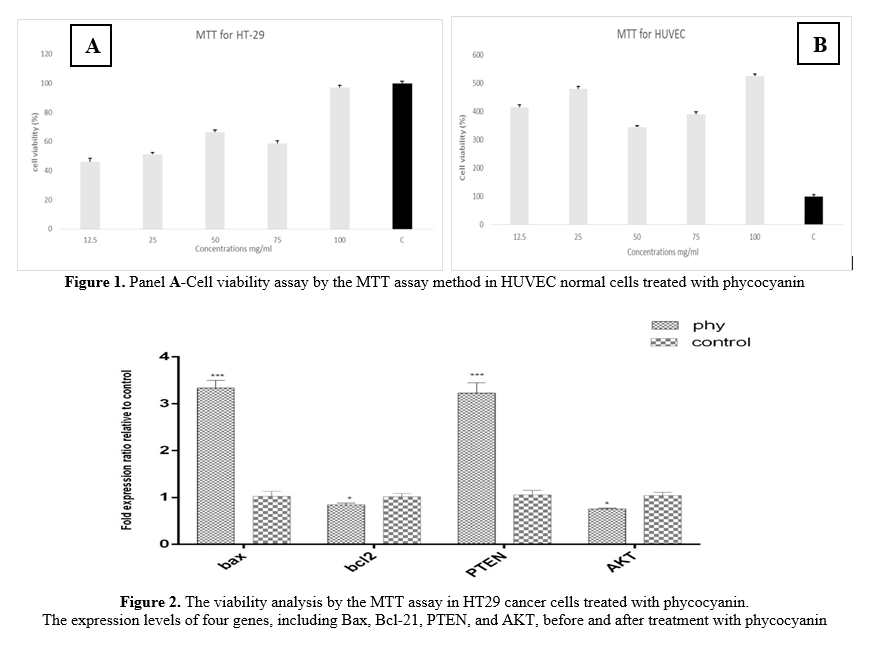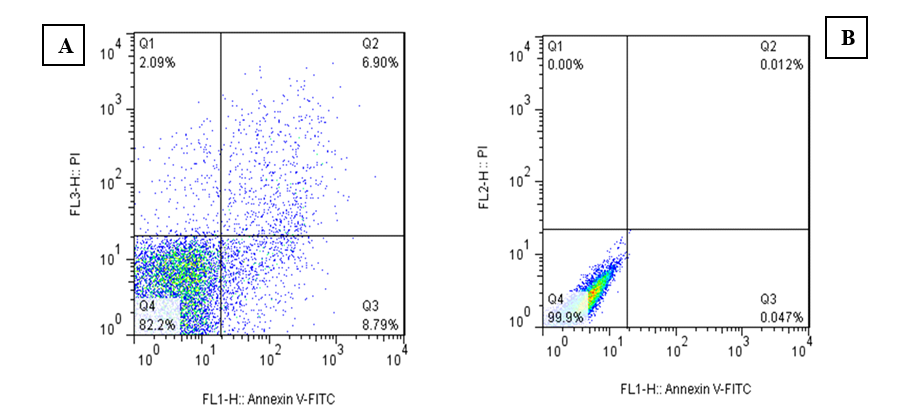1. Curado M-P, Edwards B, Shin HR, Storm H, Ferlay J, Heanue M, et al. Cancer incidence in five continents, Volume IX: IARC Press, International Agency for Research on Cancer. 2007. [
Link]
2. Alexiusdottir KK, Möller PH, Snaebjornsson P, Jonasson L, Olafsdottir EJ, Björnsson ES, et al. Association of symptoms of colon cancer patients with tumor location and TNM tumor stage. Scandinavian Journal of Gastroenterology. 2012;47(7):795-801. [
doi:10.3109/00365521.2012.672589]
3. Jemal A, Bray F, Center MM, Ferlay J, Ward E, Forman D. Global Cancer Statistics. CA: A Cancer Journal for Clinicians. 2011;61(2):69-90. [
doi:10.3322/caac.20107]
4. Hamdan NT, Jwad BA, Jasim SA. Synergistic anticancer effects of phycocyanin and Citrullus colocynthis extract against WiDr, HCT-15 and HCT-116 colon cancer cell lines. Gene Reports. 2021;22:100972. [
doi:10.1016/j.genrep.2020.100972]
5. Hashiguchi Y, Muro K, Saito Y, Ito Y, Ajioka Y, Hamaguchi T, et al. Japanese Society for Cancer of the Colon and Rectum (JSCCR) guidelines 2019 for the treatment of colorectal cancer. Int J Clin Oncol. 2020;25:1-42. [
doi:10.1007/s10147-019-01485-z]
6. Cannon-Albright LA, Skolnick MH, Bishop DT, Lee RG, Burt RW. Common inheritance of susceptibility to colonic adenomatous polyps and associated colorectal cancers. N Engl J Med. 1988;319(9):533-7. [
doi:10.1056/NEJM198809013190902]
7. Doll R, Peto R. The causes of cancer: quantitative estimates of avoidable risks of cancer in the United States today. JNCI: Journal of the National Cancer Institute. 1981;66(6):1192-308. [
doi:10.1093/jnci/66.6.1192]
8. Giovannucci E, Willett WC. Dietary factors and risk of colon cancer. Annals of Medicine. 1994;26(6):443-52. [
doi:10.3109/07853899409148367]
9. Keum N, Giovannucci E. Global burden of colorectal cancer: emerging trends, risk factors and prevention strategies. Nat Rev Gastroenterol Hepatol. 2019;16(12):713-32. [
doi:10.1038/s41575-019-0189-8] [
pmid: 31455888]
10. Zhang X, Hu P, Ding SY, Sun T, Liu L, Han S, et al. Induction of autophagy-dependent apoptosis in cancer cells through activation of ER stress: an uncovered anti-cancer mechanism by anti-alcoholism drug disulfiram. Am J Cancer Res. 2019;9(6):1266. [
pmid: 31285958]
11. Arbabi M, Hasanpoor H, Arabzadeh S, Maghami P. The Synergic effect of Abujahl watermelon extract (Citrullus colocynthis) and Phycocyanin on apoptosis inducton in human colon cancer cell line (HT-29). Cellular and Molecular Research (Iranian Journal of Biology). 2020;33(2):126-135. [
Link]
12. De Rivera CG, Miranda-Zamora R, Diaz-Zagoya J, Juárez-Oropeza M. Preventive effect of Spirulina maxima on the fatty liver induced by a fructose-rich diet in the rat, a preliminary report.Life Sciences. 1993;53(1):57-61. [
doi:10.1016/0024-3205(93)90611-6]
13. Wu XJ, Yang H, Chen YT, Li PP. Biosynthesis of fluorescent β subunits of c-phycocyanin from spirulina subsalsa in escherichia coli, and their antioxidant properties. Molecules. 2018;23(6):1369. [
doi:10.3390/molecules23061369]
14. Fernández-Rojas B, Hernández-Juárez J, Pedraza-Chaverri J. Nutraceutical properties of phycocyanin. Journal of Functional Foods. 2014;11:375-92. [
doi:10.1016/j.jff.2014.10.011]
15. Chaiklahan R, Chirasuwan N, Bunnag B. Stability of phycocyanin extracted from Spirulina sp.: Influence of temperature, pH and preservatives. Process Biochemistry. 2012;47(4):659-64. [
doi:10.1016/j.procbio.2012.01.010]
16. Strasky Z, Zemankova L, Nemeckova I, Rathouska J, Wong RJ, Muchova L, et al. Spirulina platensis and phycocyanobilin activate atheroprotective heme oxygenase-1: a possible implication for atherogenesis. Food & Function. 2013;4(11):1586-94. [
doi:10.1039/c3fo60230c]
17. Zhang DL, Wu JH, Xie LM, Liu SQ. Molecular mechanism of C-phycocyanin in alleviation of acute lung injury in septic rats. Basic & Clinical Medicine. 2014;34(7):891. [
Link]
18. Liu Y, Jovcevski B, Pukala TL. C-Phycocyanin from spirulina inhibits α-synuclein and amyloid-β fibril formation but not amorphous aggregation. Journal of Natural Products. 2019;82(1):66-73. [
Link]
19. Kehrer JP. Free radicals as mediators of tissue injury and disease. Critical Reviews in Toxicology. 1993;23(1):21-48. [
doi:10.3109/10408449309104073]
20. Romay C, Gonzalez R, Ledon N, Remirez D, Rimbau V. C-phycocyanin: a biliprotein with antioxidant, anti-inflammatory and neuroprotective effects. Current Protein and Peptide Science. 2003;4(3):207-16. [
doi:10.2174/1389203033487216]
21. Danielsen SA, Eide PW, Nesbakken A, Guren T, Leithe E, Lothe RA. Portrait of the PI3K/AKT pathway in colorectal cancer. Biochimica et Biophysica Acta (BBA) - Reviews on Cancer. 2015;1855(1):104-21. [
doi:10.1016/j.bbcan.2014.09.008]
22. Alizadeh S, Esmaeili A, Omidi Y. Anti-cancer properties of Escherichia coli Nissle 1917 against HT-29 colon cancer cells through regulation of Bax/Bcl-xL and AKT/PTEN signaling pathways. Iranian Journal of Basic Medical Sciences. 2020;23(7):886-93. [
doi: 10.22038/ijbms.2020.43016.10115] [
pmid: 32774810]
23. Pandurangan AK. Potential targets for prevention of colorectal cancer: a focus on PI3K/Akt/mTOR and Wnt pathways. Asian Pacific Journal of Cancer Prevention. 2013;14(4):2201-05. [
doi:10.7314/APJCP.2013.14.4.2201]
24. Patel A, Mishra S, Pawar R, Ghosh P. Purification and characterization of C-Phycocyanin from cyanobacterial species of marine and freshwater habitat. Protein Expression and Purification. 2005;40(2):248-55. [
doi:10.1016/j.pep.2004.10.028]
25. Tantirapan P, Suwanwong Y. Anti-proliferative effects of C-phycocyanin on a human leukemic cell line and induction of apoptosis via the PI3K/AKT pathway. Journal of Chemical and Pharmaceutical Research. 2014;6(5):1295-301. [
Link]
26. Wang J, Jiang YF. Natural compounds as anticancer agents: Experimental evidence. World J Exp Med. 2012;2(3):45. [
doi:10.5493/wjem.v2.i3.45] [
pmid: 24520533]
27. Jiang L, Wang Y, Yin Q, Liu G, Liu H, Huang Y, et al. Phycocyanin: a potential drug for cancer treatment. J Cancer. 2017;8(17):3416. [
doi:10.7150/jca.21058] [
pmid: 29151925]
28. Qian S, Wei Z, Yang W, Huang J, Yang Y, Wang J. The role of BCL-2 family proteins in regulating apoptosis and cancer therapy. Front Oncol. 2022;12:985363. [
doi:10.3389/fonc.2022.985363]
29. Gao F, Huang W, Zhang Y, Tang S, Zheng L, Ma F, et al. Hes1 promotes cell proliferation and migration by activating Bmi-1 and PTEN/Akt/GSK3β pathway in human colon cancer. Oncotarget. 2015;6(36):38667. [
doi:10.18632/oncotarget.5484] [
pmid: 26452029]
30. Ismail NI, Othman I, Abas F, H. Lajis N, Naidu R. Mechanism of apoptosis induced by curcumin in colorectal cancer. Int J Mol Sci. 2019;20(10):2454. [
doi:10.3390/ijms20102454]
31. Cheng H, Jiang X, Zhang Q, Ma J, Cheng R, Yong H, et al. Naringin inhibits colorectal cancer cell growth by repressing the PI3K/AKT/mTOR signaling pathway. Experimental and Therapeutic Medicine. 2020;19(6):3798-804. [
doi:10.3892/etm.2020.8649]










































 , Reza Najafipour2
, Reza Najafipour2 

 , Amir Hadi Hosseini3
, Amir Hadi Hosseini3 

 , Faezeh Razi4
, Faezeh Razi4 

 , Iman Salahshourifar5
, Iman Salahshourifar5 

 , Mohammad Zareian Jahromi6
, Mohammad Zareian Jahromi6 

 , Asghar Parsaei7
, Asghar Parsaei7 

 , Hossein Piri *8
, Hossein Piri *8 




